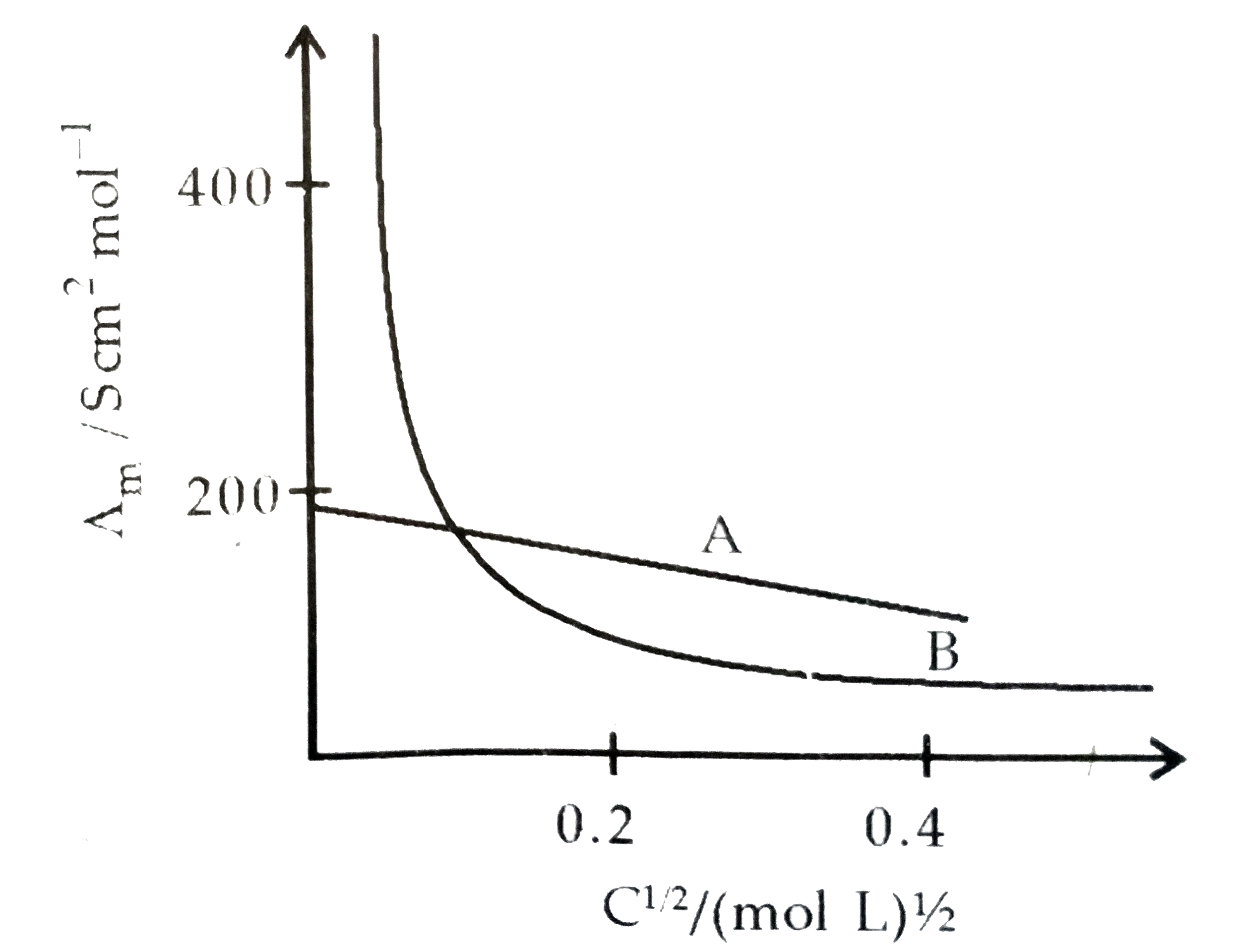Resistivity is reciprocal of molar conductivity of electrolyte.
The correct Answer is:F
To solve the question regarding the relationship between resistivity and molar conductivity of an electrolyte, we can follow these steps:
Step 1: Understand the Definitions
- Resistivity (ρ): This is a property of a material that quantifies how strongly it resists the flow of electric current. It is measured in ohm-meters (Ω·m).
- Molar Conductivity (Λ): This is defined as the conductivity of an electrolyte solution divided by the molar concentration of the electrolyte. It is measured in S·m²/mol.
Step 2: Relationship Between Resistance, Resistivity, and Conductivity
- According to Ohm's Law, the resistance (R) of a conductor is given by the formula:
R=VI
where V is the voltage and I is the current.
- The resistance can also be expressed in terms of resistivity (ρ):
R=ρLA
where L is the length of the conductor and A is the cross-sectional area.
Step 3: Conductivity and Its Relation to Resistivity
- Conductivity (κ) is the reciprocal of resistivity:
κ=1ρ
Step 4: Molar Conductivity and Its Relation to Conductivity
- Molar conductivity (Λ) is related to conductivity (κ) by the equation:
Λ=κC
where C is the molar concentration of the electrolyte.
Step 5: Establishing the Relationship
- The question states that resistivity is the reciprocal of molar conductivity. However, this is not correct. The correct relationships are:
ρ=1κandκ=Λ⋅C1
- Therefore, resistivity is not the reciprocal of molar conductivity. Instead, resistivity is related to conductivity, and molar conductivity is a separate concept that relates to how well a solution conducts electricity based on its concentration.
Conclusion
- The statement that "resistivity is reciprocal of molar conductivity of electrolyte" is false. Resistivity is the reciprocal of conductivity, not molar conductivity.
- Resistivity (ρ): This is a property of a material that quantifies how strongly it resists the flow of electric current. It is measured in ohm-meters (Ω·m).
- Molar Conductivity (Λ): This is defined as the conductivity of an electrolyte solution divided by the molar concentration of the electrolyte. It is measured in S·m²/mol.
- According to Ohm's Law, the resistance (R) of a conductor is given by the formula:
R=VI
where V is the voltage and I is the current.
R=ρLA
where L is the length of the conductor and A is the cross-sectional area.
- Conductivity (κ) is the reciprocal of resistivity:
κ=1ρ
- Molar conductivity (Λ) is related to conductivity (κ) by the equation:
Λ=κC
where C is the molar concentration of the electrolyte.
- The question states that resistivity is the reciprocal of molar conductivity. However, this is not correct. The correct relationships are:
ρ=1κandκ=Λ⋅C1
- Therefore, resistivity is not the reciprocal of molar conductivity. Instead, resistivity is related to conductivity, and molar conductivity is a separate concept that relates to how well a solution conducts electricity based on its concentration.
- The statement that "resistivity is reciprocal of molar conductivity of electrolyte" is false. Resistivity is the reciprocal of conductivity, not molar conductivity.
Topper's Solved these Questions
- ELECTROCHEMISTRYBOOK - CENGAGE CHEMISTRY ENGLISHCHAPTER - ELECTROCHEMISTRYEXERCISE - Archieves (Linked Comprehension )
13 Videos
- ELECTROCHEMISTRYBOOK - CENGAGE CHEMISTRY ENGLISHCHAPTER - ELECTROCHEMISTRYEXERCISE - Archieves Multiple Correct Ansers
2 Videos
- ELECTROCHEMISTRYBOOK - CENGAGE CHEMISTRY ENGLISHCHAPTER - ELECTROCHEMISTRYEXERCISE - Exercisefill In The Blanks
25 Videos
- D AND F BLOCK ELEMENTSBOOK - CENGAGE CHEMISTRY ENGLISHCHAPTER - D AND F BLOCK ELEMENTSEXERCISE - Archives Subjective
29 Videos
- GENERAL PRINCIPLES AND PROCESS OF ISOLATION OF ELEMENTSBOOK - CENGAGE CHEMISTRY ENGLISHCHAPTER - GENERAL PRINCIPLES AND PROCESS OF ISOLATION OF ELEMENTSEXERCISE - Archives (Subjective)
14 Videos
Similar Questions
Knowledge Check
Assertion:Kohlrausch law helps to find the molar conductivity of weak electrolyte at infinite dilution.
Reason:Molar conductivity of a weak electrolyte at infinite dilution cannot be determined experimentally.AIf both assertion and reason are true and reason is the correct explanation of assertion .BIf both assertion and reason are true but reason is not the correct explanation of assertion .CIf assertion is true but reason is false .DIf both assertion and reason are false .
The conductivity of a strong electrolyte:
View SolutionDefine conductivity and molar conductivity for the solution of an electrolyte. Discuss their variation with concentration.
View SolutionWhat is the effect of decreasing concentration on the molar conductivity of a weak electrolyte?
View SolutionThe following curve is obtained when molar conductivity (∧m) is plotted against the square root of concentration, c1/2 for two electrolytes A and B
(a) How do you account for the increase in the molar conductivity of the electrolyte A on dilution.

(b) As seen from the graph, the value of limiting molar conductivity (∧0m) for electrolyte B cannot be obtained graphically. How can this value be obtained?1
View SolutionSTATEMENT 1 Using koihlrausch's law of independent migration of ions it is possible to calculate ∧∘ for anyelectrolyte form the λ∘ of individual ions
STATEMENT 2 : Limiting molar molar conductivity of na electrolyte can be repersented as the sum of hte individual contribution of the anion and cation of hte electrolyte
STATEMENT 3: When concentration appraches zero molar conductivity reaches the lowest limit
View SolutionHow is the unit of molar conductivity arrived ?
View SolutionStatement-I: Molar conductivity of a weak electrolyte at infinite dilution cannot be determined experimenttally.
Because Statement-II: Kohlrausch law help to find the moar conductivity of a weak electrolyte at infinite dilution.
View Solution
